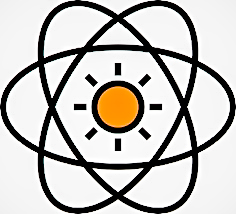 Introduction to Quantum Mechanics
Introduction to Quantum Mechanics 
From Wikipedia, the free encyclopedia 

Quantum mechanics is the science of the very small. It explains the behavior of matter and its interactions with energy, on the scale of atoms and subatomic particles. By contrast, classical physics only explains matter and energy on a scale familiar to human experience, including the behavior of astronomical bodies such as the Moon. 
Classical physics is still used in much of modern science and technology. However, towards the end of the 19th century, scientists discovered phenomena in both the large (macro) and the small (micro) worlds that classical physics could not explain. Coming to terms with these limitations led to two major revolutions in physics, which created a shift in the original scientific paradigm, thus spawning the theory of relativity and the development of quantum mechanics. 
This article describes how physicists discovered the limitations of classical physics and developed the main concepts of the quantum theory that replaced it in the early decades of the 20th century. These concepts are described in roughly the order in which they were first discovered. For a more complete history of the subject, see History of Quantum Mechanics. 
Light behaves in some respects like particles, and in other respects like waves. Matter, the “stuff” of the universe, consisting of particles such as electrons and atoms, exhibits wavelike behavior too. Some light sources, including neon lights, give off only certain frequencies of light. 
Quantum mechanics shows that light, along with all other forms of electromagnetic radiation, comes in discrete units called photons, and predicts light’s energies, colors, and spectral intensities. A single photon is a quantum, or smallest observable amount, of the electromagnetic field, because a partial photon has never been observed. More broadly, quantum mechanics shows that many quantities, such as angular momentum, that appeared to be continuous in the zoomed-out view of classical mechanics, turn out to be (at the small, zoomed-in scale of quantum mechanics) quantized. Angular momentum is required to take on one of a set of discrete allowable values, and since the gap between these values is so minute, the discontinuity is only apparent at the atomic level. 
Many aspects of quantum mechanics are counterintuitive and can seem paradoxical, because they describe behavior quite different from that seen at larger length scales. In the words of quantum physicist Richard Feynman, quantum mechanics deals with “nature as She is, absurd.” For example, the uncertainty principle of quantum mechanics means that the more closely one pins down one measurement (such as the position of a particle), the less accurate another measurement pertaining to the same particle (such as its momentum) must become. 
1. Quantum mechanics is the study of:
a) submarines
b) atomic bombs
c) atoms and subatomic particles
2. Classic physics is the study of:
a) micro worlds
b) science fiction
c) macro worlds
3. Light can behave like:
a) particles
b) waves
c) both a and b
4. Light is made up of units called:
a) photons
b) atoms
c) molecules
5. The smallest observable amount of the electromagnetic field is:
a) a wave
b) a quantum
c) radiation




















